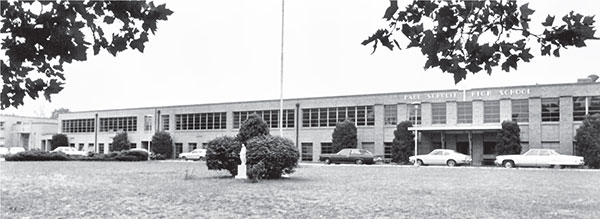
The building is now home to Corporate Square, at 2901 Ohio Boulevard. Courtesy Vigo County Historical Society.
JUNE
JUNE 1
1924—Camp Krietenstein
A bronze tablet was unveiled at Camp Krietenstein in memory of Ensign Carl Krietenstein, who died in 1920 while in service of the U.S. Navy. When the growth of Boy Scout membership required a new camp in 1922, George Krietenstein gave a farm on the Eel River in Clay County to the Terre Haute Council of Boy Scouts of America in memory of his son. B.E. Stahl delivered the ceremonial address to 150 Boys Scouts, leaders and friends. The words of Max Ehrmann, inscribed on the tablet, closed with “justice, liberty and progress are more sacred even than life.” Following this generous gift, a large lodge was built on the campgrounds by the Terre Haute Rotary Club. The Boy Scouts had been organized in the city since 1912; the Wabash Valley Council was incorporated in 1926.
JUNE 2
1929—City Manager Campaign
The Terre Haute League of Women Voters, led by Pansy Gleason, staged an active campaign for Terre Haute to change to a “city manager” form of government. Covering the June election, the Terre Haute Star reported, “General light vote over city spells doom for campaign to adopt new government here. Factions wage close battle at polls with plan opponents piling up a total of 8,401 votes to 7,248 for manager. Now the city will take up again the usual procedure for a primary and city election.” J. Bruce Bindley, chairman of the Citizens Government League and one of the first sponsors of the movement, said, “The vote indicates that the people of Terre Haute do not want to change their system of government. That seems clear. Personally, I should not have wanted to win by a small majority, for then the new form would not have been strong enough.”
JUNE 3
1958—Schulte High School
Ground was broken for the new convent, chapel and addition to the Paul Schulte High School. Rapid growth forced the school to expand with seven more classrooms. The Reverend Joseph V. Beechem expected enrollment to be five hundred students in the fall. Schulte was Terre Haute’s first coeducational Catholic high school. It had opened on September 14, 1953, with an enrollment of 243. A student vote decided the school mascot, the Golden Bear. Its yearbook was the Mitre and its paper the Schultean. The green and gold varsity football team of 1954 grew under the leadership of Coach Pete Varda into the 1957 city co-champions. In 1960, Schulte became the first local high school to have its own football field: Beech-Var Stadium. The class of 1977 was the last to graduate from the school before it closed. Alumni dedicated the Golden Bear statue on the site in 2015.

The building is now home to Corporate Square, at 2901 Ohio Boulevard. Courtesy Vigo County Historical Society.
JUNE 4
1939—City Buses Take Over
“A different tone in the usual clamor of the city was noted in Terre Haute Sunday morning,” reported the Terre Haute Tribune and Sunday Star.
The clang of iron wheels, the rattle of the current feeder over suspended wire and the jarring bump of the old street cars that have for many years brought Terre Haute transportation facilities had given way to the hum of rubber tires and the purr of muffled motors. This morning the new motor coaches of the Terre Haute City Lines Inc. were in operation and again several Terre Haute citizens vied with each other in riding the first motor coach serving their district. A fleet of thirty-six new motor coaches…will now furnish the transportation for the city…Painted a vivid yellow…they have two doors, one at the front where patrons enter and drop their five cent fare into an electric change box.
JUNE 5
1963—Dresser Birthplace
A crowd gathered at 318 South Second Street to watch workmen begin moving the small brick house in which Paul Dresser was born on April 22, 1858. It would be moved from the urban renewal area to Fairbanks Park by Elmer Buchta, a moving contractor from Otwell, Indiana, for the sum of $4,684. His workmen boxed in the old home with cables and metal strapping as though it were a large box and delicately moved it on dollies over the half mile to the park site. The Vigo County Historical Society had formed the Paul Dresser Birthplace Preservation Committee in 1961 with Dorothy J Clark as chairperson. Saving this pre–Civil War working man’s home in honor of Dresser, composer of the Indiana state song, “On the Banks of the Wabash Far Away” became known statewide. The dedication took place on July 6, 1966.
JUNE 6
1959—Shopping Centers
This day concluded the opening celebration of Southland at South Seventh Street and Margaret Avenue. The corporation officers—D.C. Johnson, Forrest Sherer and Carl Graham—and Mayor Ralph Tucker were there for the ribbon-cutting at the city’s second shopping center. Four years later, on July 29, ground was broken for Plaza North at Fort Harrison Road and Lafayette Avenue. It was a Newlin-Johnson Development Company project, as were Meadows Center and Southland.
Development plans for Honey Creek Square on the former Ijams Farm at Interstate 70 and U.S. 41 were announced on August 16, 1966, at the Holiday Inn. Sears Roebuck and Company would be the first anchor store at the new center, the largest development of its kind within a seventy-mile radius. Honey Creek Square opened in 1969 and grew into Honey Creek Mall.
Retail continued to leave Wabash Avenue. In 1972, Paul Pfister, realtor, said, “Downtown Terre Haute is not dead yet, but it is surely in need of a complete transfusion.”
JUNE 7
2008—Valley Flooded
More than sixteen inches of rain had fallen on southern Vigo County since May 31, setting the stage for this weekend disaster. With 911 emergency lines “exploding,” a state of emergency was declared in the county. The Tribune-Star reported, “Wealthy or poor, from the river bottoms to some of the area’s toniest neighborhoods, tens of thousands of Wabash Valley residents suffered the effects Saturday of biblical proportion of rain (6.83 inches) that fell over a 24-hour span.” Terre Haute North Vigo High School was designated as an emergency Red Cross shelter. Duke Energy reported more than 6,600 customers without power. At their air base, servicemen and women filled some twelve thousand forty-pound sandbags for distribution. Residents had to cope with damaged homes, furnishings and lost keepsakes, but they were thankful for no fatalities. Perhaps a yard sign in Marywood subdivision expressed this feeling well: “We are not what we own.”
JUNE 8
1948—Mills Bros. Circus
According to the Terre Haute Tribune:
The Mills Bros. Circus have their “canvas city” on the Wabash and Twenty-fifth Street show grounds. With the circus is a favorite to Terre Haute people—Doc Waddell—now a Methodist minister of the gospel and pastor of the “canvas church” which the Mills brothers—Jack, Jake, Paul and Harry—maintain for their people. This morning at daybreak, Rev. Waddell held his “service of the dawn” for the adult show folk, and followed with Sunday school for the fifty-odd children of performers. He also held special remembrance services for the late Jerry Mugivan, circus owner, “Jake” Fenn, master showman and world-known Elk, Major William Irwin, who in his day brought circuses and carnivals to Terre Haute, and all other show people and friends of the circus buried here.
An evening performance was sponsored by the Fire Fighters Association. Next stand, Crawfordsville…
JUNE 9
1967—State Visit
People were talking about the photo on the front page of yesterday’s Terre Haute Tribune showing Richard D. Wells, state school superintendent, looking at the 1885 date on Wiley High School. He was visiting Wiley, Gerstmeyer and Garfield High Schools during a “routine” inspection and noted that the condition of Wiley’s physical plant was “the worst I have ever seen.” Wiley had been built to accommodate 600 to 700 students, and enrollment was currently 1,100. Gerstmeyer, a few years older, had about 1,000 enrolled. Wells indicated his visit was prompted by the lawsuit opposing the sale of bonds to finance construction of two new high schools—one to be built on the south side and the other on the north side of the city. And he warned that based on the condition of the buildings, the two present schools could be stripped of their first-class commissions and dropped to the lowest commission rating.
JUNE 10
2001—Charles G. Abrell Monument
The Joseph A. Bray Detachment 471, Marine Corps League, dedicated a statue, created by local artist Bill Wolfe, in honor of U.S. Marine Corporal Charles G. Abrell. A Medal of Honor recipient, he had lost his life in Korea on June 10, 1951. The monument was placed on the planned plaza where one day the veterans from all America’s wars would be honored.
Two years later, ground was broken for this plaza on the southeast lawn of the courthouse. The dedication took place on May 30, 2003, with the raising of flags to each of the armed services, the POW-MIA, the City of Terre Haute and Vigo County. Monuments remembering those lost in the Korean, Vietnam, Operation Iraqi and Enduring Freedom Afghanistan wars on the south side share the courthouse grounds with those of the Civil War and World Wars I and II on the north side.
JUNE 11
2001—McVeigh Execution
Timothy James McVeigh bombed the Alfred P. Murrah Federal Building in Oklahoma City on April 19, 1995. The blast killed 168 persons, including 19 children. He was sentenced to death and moved to the U.S. Penitentiary at Terre Haute, the location of the federal execution facility. His would be the first federal execution since 1963. After the injection of three different drugs, he was pronounced dead at 7:14 a.m. by Warden Harley Lappin. Chief deputy coroner Kevin Mayes signed the death certificate. In Oklahoma City, 232 survivors and relatives of the victims viewed the execution on closed-circuit television. More than 300 anti-death penalty demonstrators circled in silence and held hands at 7:00 a.m. on the grounds of the penitentiary. About 20 pro-death penalty demonstrators cheered in another area. Indiana State Police, patrolling Indiana 63, reported that as many as 1,500 members of the media had crossed the highway.
JUNE 12
1987—Allen Chapel
The congregation of the Allen Chapel African Methodist Episcopal Church celebrated its 150th anniversary with the theme: “We’ve come this far by faith.” The congregation, formed in 1837, was the first church for African Americans in western Indiana and the location of the first school for their children in the area. Meeting in a small house near First and Sheets (Crawford) Streets, Allen Chapel and the Lost Creek AME Church were “safe houses” on the Underground Railroad. A new Allen Chapel at Third and Crawford Streets was dedicated in 1870, but a lightning strike and fire nearly destroyed the structure during the 1913 tornado. The new building, constructed on the original foundation, “literally rose from the ashes.” Membership declined when the urban redevelopment project of the 1960s forced many members to leave the area. The landmark’s place on the National Register of Historic Places honors the leadership of the Allen Chapel congregation in the local African American community through the years.
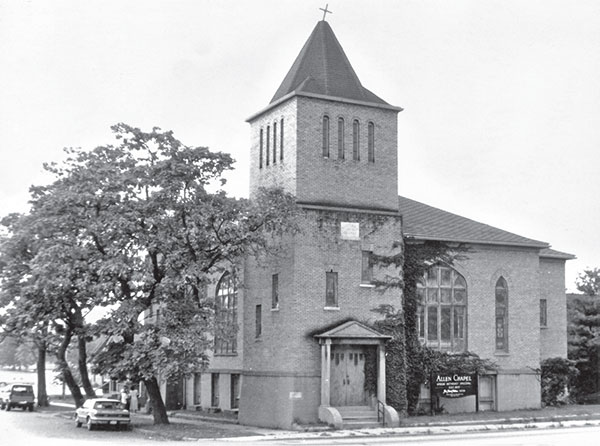
The Friends of Historic Allen Chapel was organized in 1997 to help preserve the building and its rich legacy. Courtesy Vigo County Public Library.
JUNE 13
2013—Strawberry Festival
The members of the First Congregational Church, at 630 Ohio Street, hosted their twenty-fifth annual Strawberry Festival, kicking off the summer season in downtown Terre Haute. It is the city’s largest single-day attraction. Starting small, the event has grown to church members and volunteers serving biscuits, strawberries, ice cream and whipped topping in various combinations to ten thousand or more people. Festival crowds enjoy the live music as they eat at tables under vast tents.
The Reverend Dawn Carlson credits the ladies who first initiated the festival twenty-five years ago. Libby Gelder, Carrie Werneke, Martha Ehrenhart and Dorothy Monroe attended a similar event in Indianapolis. When they saw fifty people waiting in line under a steady rainfall, they knew it could be a popular fundraiser for the church at home. They were right; it could not be more successful for both the church and the community.
JUNE 14
1908—Free Lunch
An amusing account appeared in the Terre Haute Tribune:
Free lunch for a beer, in Terre Haute—a nickel is all that is needed. At no town in Indiana is more given for the money than are dispensed over the free lunch counters by the white-aproned bartenders. By calling on several saloons and depositing a nickel in each till, a man is always able to get a good square meal…a liberal slice of cheese, a nice ham sandwich and some olives, and salad [or] a roast pork sandwich, rye bread, pickles and Mexican chili. There are many men who, although they do not drink, go regularly to saloons at lunch times, buy a glass of beer and get a hand-out of free lunch. They “dump” the beer away while the barkeep has his back turned…in Terre Haute no one is complaining, although often the free lunch has the appearance of a full meal.
JUNE 15
1966—Sesquicentennial
The weeklong celebration of Terre Haute’s progress from 1816, the year the town was laid out and platted, to 1966 was underway. “Special days” recognized various groups in the city. The Commemorative Book of Terre Haute was published, and a six-night pageant, TH 150, written by Joseph T. Newlin, was featured at Memorial Stadium. Principal actors included Ralph Courtney as Chauncey Rose, Clyde Lovellette as William Henry Harrison, Albert Light as Abe Lincoln and Mrs. John Burget Jr. as Sister Theodore. Howard E. Potter served as president of Terre Haute Heritage Inc. with headquarters at 666 Wabash Avenue. He commented, “A successful birthday party for any community doesn’t just happen. Our Terre Haute Area Sesquicentennial Celebration is the result of hundreds of persons working individually or as members of organizations in this tremendous, cooperative community-wide project.”
JUNE 16
1906—Indiana State Bank
The opening of Indiana State Bank drew attention to the progress made by businesses on the East Side. The merchants, located east of the railroad tracks at Tenth Street, had met the previous November at the office of Dr. L McClain to discuss the need of a bank in their own section of the city. A committee was named, and more meetings were held at the Armory until the bank was organized in a very short time with a capital stock of $35,000. A lot was purchased at 1211 Wabash Avenue, on which the bank building was constructed. A large parking lot to the rear of the building was added about fifty years later for the convenience of customers. Indiana State Bank merged with Old National Bank Corporation in 1994 and served as a banking center from 1996 to 2003. The Terre Haute Police Department moved into the building in 2004.
JUNE 17
1967—Fowler Park
Two years following the establishment of the Vigo County Parks Department, Fowler Park became its first resource. As the story goes, county commissioner Harry Brentlinger and Peabody Coal Company struck a deal. The county would move and close county roads to facilitate Peabody mining interests if the company would give something in return. The 140 acres became Fowler Park, named for Captain Eugene R. Fowler, the first man from Vigo County to lose his life in the Vietnam War. The park has been expanded several times. Irishman’s Covered Bridge, built in 1845 over Honey Creek about three miles west of Riley, was moved to the park in 1971. Pioneer Village, made up of eighteen structures built through the labor and leadership of W. Keith Ruble, superintendent from 1973 to 2013, is a major attraction during the annual Pioneer Days and Christmas Walk events.
JUNE 18
1918—State Normal at Muncie
Dr. William Wood Parsons, now president of both the Muncie and Terre Haute institutions, opened the eastern branch at chapel exercises. The Muncie branch had been redecorated and repaired in preparation for the entrance of its first 235 students. The control of operations at Muncie Institute had been granted to Indiana State Normal School at Terre Haute by the Indiana General Assembly. This necessitated a substantial increase in the number of faculty members employed by the Terre Haute school. It was also an indication of its growth along many lines. The Muncie branch became Ball State Teachers College in 1929 and fully independent of Indiana State College in 1961.
JUNE 19
1841—Saint Mary’s Academy
Less than a year after her arrival at Thralls Station, now Saint Maryof-the-Woods, Mother Theodore, founder of the Sisters of Providence, placed this advertisement in the Wabash Courier: “Saint Mary’s Academy for Young Ladies, situated four miles northwest of Terre Haute will open the second of July.” Seventeen subjects—from arithmetic to tapestry and writing—and boarding were offered at $100 per annum. Extra charges would be added for the five languages, art supplies, washing and mending, stationery and medicine. Pay was required in advance. The first student arrived on July 4, and eight more by the end of the month. The cabin school grew into an academy for young girls and then into Saint Mary-of-the-Woods College, the first Catholic liberal arts college for women in the nation. The decision to become a fully coeducational institution was made in 2015.
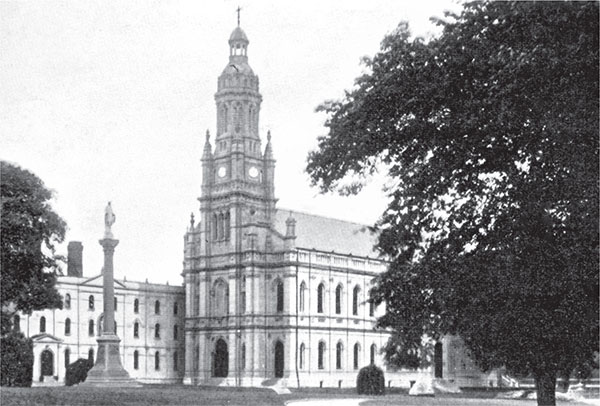
The Church of the Immaculate Conception, completed in 1891 and consecrated in 1907, is the heart of the campus. Courtesy J.S. Calvert Collection.
JUNE 20
1903—New Bridge Underway
Preparation for a new bridge over the Wabash River connecting Terre Haute and West Terre Haute began; by August, a drop hammer was driving the pilings twenty feet into the riverbed. David M. Buchanan, former executive director of the Vigo County Historical Society, described the construction:
The bridge was composed of six 120-foot spans built of riveted steel trusses. Three plate girders were laid equidistant between these trusses. Flat steel plates were attached to the girders and the brick was laid on the plates. The roadway was about fourteen feet above the elevation of the old bridge floor allowing the bridge to be almost thirty-eight feet above low water. The contractor was the Lafayette Engineering Company with Frank Hanna of Terre Haute as the general manager.
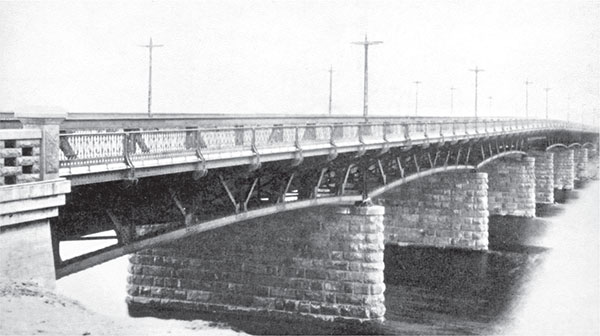
Dedication ceremonies were held on October 17, 1905, with the West Terre Haute Band leading the parade across the bridge. Courtesy J.S. Calvert Collection.
JUNE 21
2000—Baesler’s Market
Bob Baesler held the ribbon as his mother, Vera Baesler, cut it for the grand opening of his new store located just east of The Meadows shopping center. One year earlier, Baesler, a fourth-generation grocer, had announced plans to enlarge and update his business in order to remain competitive. The new building, five times larger than his former store, was open twenty-four/seven with a bakery, delicatessen and gasoline station.
The Baesler family had been in the grocery business since 1894, when Bob’s great-grandfather, George Baesler, and Herman Wittenbrock opened a meat market at 1373 Wabash Avenue. The store became Baesler’s Market in 1906. George’s son, Herman, and grandson, Charles, later became part of the business. The family acquired Ralph’s Market at 1101 South Twenty-fifth Street in 1963. Bob entered the business in 1973; the store was operated by this father-son team until Charles died in 1987.
JUNE 22
1928—Gillis Drug Company
The Gillis Drug Company, owner and operator of six downtown drugstores, ran large advertisements in both the morning Terre Haute Star and the afternoon Terre Haute Tribune. Old Gold cigarettes were $2.00 per carton, and three brands of cigars were kept fresh in humidor cases. Rapid-Shave Cream was $0.45 and Brownie cameras $2.50 and up. Each store offered fountain and luncheonette service with daily menu changes. Four stores were located on Wabash Avenue between Fourth and Ninth Streets, one at South Seventh and Ohio and another at North Seventh and Cherry in the Rose Dispensary. Gillis Drug, headed by James C. Gillis, was a “Terre Haute institution owned and operated by Terre Haute people.” It is now almost difficult to picture the Gillis stores and one Hook Drug, along with Baur, Hampton, Hoffman, Kohl and Shandy pharmacies, in business at the same time in downtown Terre Haute.
JUNE 23
1932—Plane Crash
According to the Terre Haute Star, “The lives of Paul Cox, twenty-six years old, and William R. Root, thirty years old, members of prominent Terre Haute families, were killed when the airplane in which they were returning from Owensboro, Kentucky, crashed into a field two miles south of Farmersburg and one-half mile west of U.S. 41.” The plane was flying north, only a short distance above the ground; it suddenly flew upward and then nosed downward into the earth on their way back to Dresser Field. Both Cox and Root were charter members of the Terre Haute Aero Club and active boosters of local aviation. Dresser Field, South Seventh Street and Davis Avenue, was renamed Paul Cox Field in 1933.
JUNE 24
1927—Bud Taylor
Bud Taylor, the “Blonde Terror of Terre Haute,” claimed the bantam weight championship of the world with his win over Tony Canzoneri before a crowd of fifteen thousand at Wrigley Field in Chicago. Blow-by-blow returns were provided by Jack Hannah, Terre Haute Star sports editor, from ringside in Chicago. These were broadcast by the newspaper and WRPI, Rose Polytechnic radio station, to hundreds of persons who blocked the intersection of Ohio and Sixth Streets. It was “a brand new method—an electrical public address system.”
Born in 1903 in Terre Haute, Taylor turned professional at the age of seventeen and fought nearly fifteen times a year during his career. His Hall of Fame biography (2005) reads, “Taylor possessed a hard right hand, left hook and tremendous stamina. This crowd-pleasing style enamored him to fans. He retired from the ring in 1931 with a 70-23-6, 58ND (35 KOs) record.”
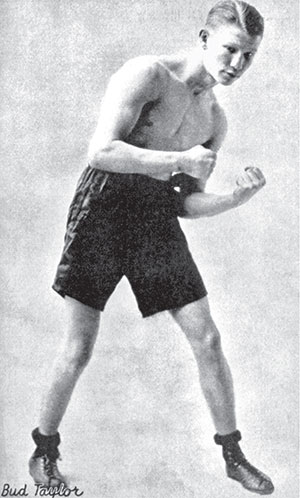
The first-ever biography of Taylor, written by John D. Wright in 2008, described Taylor as “a star when the popularity of boxing ranked second only to baseball.” Courtesy J.S. Calvert Collection.
JUNE 25
1935—Goodwill Industries
The Rotary Club, a strong supporter of Goodwill since its founding in 1927 by the Reverend Ted Grob, was honored this Thursday. The day was part of the celebration dedicating the building at 120–22 North Fifth Street, where persons with disabilities were employed and contributed items were available for purchase by those in need. Journalist Gladys Seltzer wrote:
In April, 1930, a crew of unemployed men began digging the basement…with pick and shovel, and they were paid one dollar a day in cash supplemented by food, clothing and coal…With the basement begun, Reverend Grob started to search for salvage materials…and by the time the building was completed it would contain salvage materials from seven homes, three churches, two factories, one post office and one hotel. It was the only Goodwill building in the nation constructed entirely from salvaged materials.
Fifty-five years later, Wabash Valley Goodwill Industries moved to 2702 South Third Street.
JUNE 26
1999—Community Band
The Terre Haute Concert band, founded in 1985 by David McConkey, presented its second “Twilight Melodies” concert of the summer season at Fairbanks Park. After this performance, McConkey resigned for health reasons and members Ron Dunbar, Marcia Meurer and James Chesterson reorganized the band as a nonprofit organization—the Terre Haute Community Band, Inc. It is dedicated to promoting live public performance and enjoyment of concert band and orchestral music through concerts by the band and its sister organization, the Terre Haute Sinfonietta Pops Orchestra. The unpaid musicians, age fifteen to eighty-plus years, enjoy the opportunity to perform. The free band concerts in the Fairbanks Park amphitheater each summer attract a variety of people. Betty Martin, board secretary, commented, “The outdoor band concert symbolizes many of the old fashioned virtues of a simpler time.”
JUNE 27
1956—Mayor Tucker Wins Nomination
Howard Stevens, Terre Haute Tribune political writer, reported the news from Indianapolis:
Ralph Tucker, unprecedented three-time mayor of Terre Haute who battled his way from an orphanage up into the rough and tumble life of politics, will be the Democratic candidate for Governor of Indiana in next fall’s election…Tucker out-maneuvered top echelon political leaders and defeated his last remaining opponent, early favorite Matthew Welsh of Vincennes, on the ninth ballot.
Upon their return home, Tucker and his family were greeted at the city limits by a crowd of well-wishers who formed a parade leading to City Hall Tucker, wearing his trademark white hat, was photographed hugging eightyseven-year-old Ernest Alden, who had been in charge of the Rose Orphanage at the time Tucker lived there. In November, President Eisenhower pulled most Republican candidates to victory, but Tucker did the best of the three major Democrat candidates with 42.3 percent of the vote.
JUNE 28
1979—Indiana Special Olympics
State competition for the Indiana Special Olympics opened at Indiana State University, site of the event for the tenth straight year. Mel Daniels, ISU assistant basketball coach and former professional basketball player, was the honorary coach. Units from the local Zorah Shrine took part in the opening ceremonies. The Indiana Air National Guard provided the color guard for the parade of athletes. A disco dance and a carnival staged by local Catholic churches and the Gibault School for Boys followed the ceremony. Athletic events, including track, diving, gymnastics, frisbee throwing and bowling filled the weekend for 2,500 athletes, coaches and their families.
The first state games were held at Bush Stadium in Indianapolis in 1969, but the site proved too small for the event. Alan C. Rankin, then ISU president, urged faculty members Tom Songster and Judy Campbell to try to bring the Special Olympics to campus, and they succeeded.
JUNE 29
1884—“Hot Whiskey”
The Terre Haute Express called the burning of the Fairbanks and Duenweg’s Distillery, located on the riverbank south of the city, one of the largest fires in the history of Terre Haute. The firefighters responded promptly, but by the time they arrived, the structure was past saving. The fire completely destroyed the large distillery, which used more than one thousand bushels of corn daily. A total of three hundred hogs, several cattle and fifteen thousand gallons of high wines (distillate) were also destroyed. Large crowds watched the fierce flames, aided by the exploding tanks of high wines, shooting above the six streams of water raised by the firefighters. The stopping of production also affected the office of the Collections of Internal Revenue. Eleven of its fourteen employees were suspended. Crawford Fairbanks said they would rebuild the distillery with a brick building.
JUNE 30
1923—Terre Haute Savings Bank
R.N. Filbeck, president of the Terre Haute Savings Bank, told the Terre Haute Tribune that the comptroller of currency had reported 618 savings banks in operation in the nation. He explained the difference between a savings bank and the standard banks—no real estate or insurance departments and no safety deposit boxes. The customers deposit their savings and reap interest from first mortgages on real estate held by the bank. The bank, chartered in 1869, moved into its own six-story building at Ohio and Sixth Streets in 1911. More services were added; for years, the bank was known as “the home of school savings.” Levin Brothers occupied the upper floors of the building until discontinuing business in 1968.
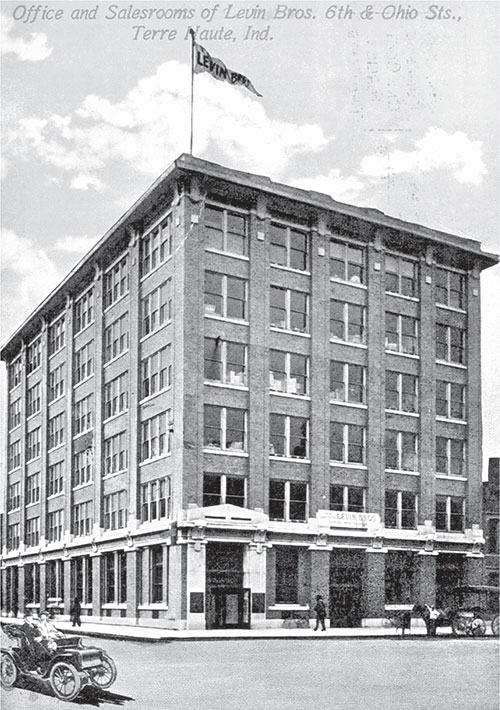
The top five floors of the building were removed in 1972, and an extensive remodeling project was completed in 1989. Courtesy J.S. Calvert Collection.